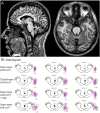Vestibular Hypofunction in ARSACS Syndrome: A Possible Pitfall in the Differential Diagnosis of Recessive Cerebellar and Afferent Ataxias
- PMID: 38152064
- PMCID: PMC10751013
- DOI: 10.1212/CPJ.0000000000200239
Vestibular Hypofunction in ARSACS Syndrome: A Possible Pitfall in the Differential Diagnosis of Recessive Cerebellar and Afferent Ataxias
Abstract
Objectives: Autosomal recessive spastic ataxia of Charlevoix-Saguenay (ARSACS) is an early-onset ataxia characterized by cerebellar dysfunction, spasticity, and sensory-motor polyneuropathy due to variations in the SACS gene (13q11). To date, no studies have instrumentally assessed vestibular function in this condition.
Methods: We report a 36-year-old woman with diagnosis of ARSACS syndrome due to homozygous mutation (c.12232 C>T, p.Arg4078Ter) in the SACS gene. Neurologic examination showed spastic-ataxic gait, dysarthric speech, 4-limb ataxia, and spastic hypertonia with lower limb hyperreflexia.
Results: A vestibular instrumental evaluation including bedside oculomotor testing found gaze-evoked and rebound nystagmus on horizontal and vertical gaze, saccadic movements within normality ranges, saccadic pursuit, and slightly impaired visually enhanced vestibulo-ocular reflex (VVOR). A near-normal VOR suppression (VORS) was recorded. Neither head shakings, skull vibrations, nor supine positionings could evoke nystagmus. Finally, the video-head impulse test detected a symmetrical VOR impairment for all the semicircular canals (SCs), mostly involving the horizontal SCs, with corrective saccades in all planes.
Discussion: Vestibular hypofunction may be found in ARSACS syndrome and may represent a possible pitfall in the differential diagnosis of recessive cerebellar and afferent ataxias. In this setting, ARSACS syndrome should be considered in the differential diagnosis of CANVAS.
© 2023 American Academy of Neurology.
Conflict of interest statement
The authors report no relevant disclosures. Full disclosure form information provided by the authors is available with the full text of this article at Neurology.org/cp.
Figures



Similar articles
-
Corrective Saccades in Unilateral and Bilateral Vestibular Hypofunction During Slow Rotation Expressed by Visually Enhanced VOR and VOR Suppression: Role of the Cerebellum.Cerebellum. 2021 Oct;20(5):673-677. doi: 10.1007/s12311-019-01066-w. Cerebellum. 2021. PMID: 31396823
-
[Cerebellar ataxia with neuropathy and vestibular areflexia syndrome (CANVAS): a case report].Rinsho Shinkeigaku. 2019 Jan 30;59(1):27-32. doi: 10.5692/clinicalneurol.cn-001209. Epub 2018 Dec 29. Rinsho Shinkeigaku. 2019. PMID: 30606994 Japanese.
-
Autosomal Recessive Spastic Ataxia of Charlevoix-Saguenay (ARSACS) in a Thai Patient: The Classic Clinical Manifestations, Funduscopic Feature, and Brain Imaging Findings with a Novel Mutation in the SACS Gene.Tremor Other Hyperkinet Mov (N Y). 2020 Jun 8;10:1. doi: 10.5334/tohm.68. Tremor Other Hyperkinet Mov (N Y). 2020. PMID: 32775015 Free PMC article.
-
[Spastic ataxia of Charlevoix-Saguenay: the first Russian case report and literature review].Zh Nevrol Psikhiatr Im S S Korsakova. 2020;120(2):85-91. doi: 10.17116/jnevro202012002185. Zh Nevrol Psikhiatr Im S S Korsakova. 2020. PMID: 32307416 Review. Russian.
-
Insights into SACS pathological attributes in autosomal recessive spastic ataxia of Charlevoix-Saguenay (ARSACS)☆.Curr Opin Chem Biol. 2022 Dec;71:102211. doi: 10.1016/j.cbpa.2022.102211. Epub 2022 Sep 17. Curr Opin Chem Biol. 2022. PMID: 36126381 Review.
Cited by
-
Best Oculomotor Endpoints for Clinical Trials in Hereditary Ataxias: A Systematic Review and Consensus by the Ataxia Global Initiative Working Group on Digital‑Motor Biomarkers.Cerebellum. 2025 Aug 13;24(5):141. doi: 10.1007/s12311-025-01894-z. Cerebellum. 2025. PMID: 40801974 Free PMC article.
References
-
- Hlavnička J, Růžičková H, Tykalová T, Novotny` M, Rusz J. Dysarthria analyzer. Beta Version. 2022. Accessed December 20, 2022. ([computer program]). dysan.cz/
Publication types
LinkOut - more resources
Full Text Sources
